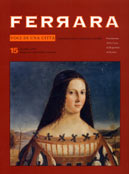These three articles, interweaving violence and blood, bear witness to the pitilessness of power and the implacability of the vendetta. Costanza Cavicchi's work on Girolamo da Carpi can be seen in contrast with the article by Pierluigi Cervellati on the relationship between Ferrara and its surroundings, portraying and constructing scenarios of the future of our city and of its vital ties with its territory. Contemporary Ferrara is present in Vittorio Emiliani's description of his schoolboy years at the Liceo Ariosto and his encounters with teachers and schoolmates who became familiar faces in the Ferrara of the century just ended.
Finally, to round off this issue, we have a little-known piece by Govoni, a sort of autobiography in miniature, presented by Sergio Raimondi, Gianluca Villa's reminiscences of a great violinist, Aldo Ferraresi, and accounts of the Norwegian landscape exhibition, currently showing at the Diamanti, and of the new digital mapping CD-ROM, by Maria Luisa Pacelli and Paola Zanardi respectively.
It seems to me that the authority and readability of the articles in this number make this an issue to remember, outstanding among the output of this already mature magazine. An example, in other words, of the type of serious cultural publication desired by the Foundation and by the Cassa di Risparmio; reclaiming and displaying the vast cultural heritage of Ferrara and the knowledge of what it is that makes us ferraresi: the key to our identity.



